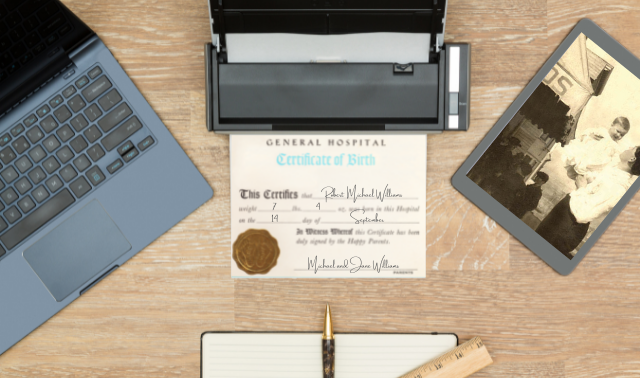|
Subscribe to Family Tree Magazine now and save 62%  | | Family Tree Preview | | | | Key Steps to Reducing Your Genealogy Paper Clutter | | Doing genealogy research sometimes feels more like pushing paper than pursuing ancestors. Binders, folders, journals, books, printouts and notes can create a roadblock more daunting than your most challenging brick wall. Still, many genealogists cringe at the word paperless. Paper lasts, they say: Printed notes and vital records don’t disappear with the crash of a hard drive. You don’t need a special device to read a 100-year-old letter on paper. That’s true, of course. But managing a mountain of genealogy-related paper costs you money, space and time. Paper overflowing on your desk, in drawers and on shelves dilutes your focus, and organizing it takes away from valuable genealogy search time. So what if you claim territory in the middle ground, where you thoughtfully select which family history documents you really need, dispose of the rest and develop habits that keep more paper from entering your home? Not paperless, but less paper. We’ll show you the best ways to navigate a path to less paper and more genealogy productivity. | | | Here's a preview of what our readers found so useful in the article! | | | | | Have a goal in mind | | The first step in planning a journey is knowing where you’re going—having a target destination that serves as your goal. The same is true when it comes to organization, so set a goal to reduce your paper load. As a result, your genealogy research will be more enjoyable and the paper documents that are most important to manage and preserve will receive the attention they deserve. | | | Gather your working genealogy documents | | Your everyday handwritten and computerized research notes belong with your working documents. It’s not necessary to print out a new family group sheet every time you add information to your genealogy software. If you regularly back up your computer, that information is safe in its “born digital” format, so don’t waste the paper. Other working documents include magazines and newsletters, receipts, research logs and plans, printed results from library catalog searches, pedigree charts and other reports, email messages, downloaded books and documents from genealogy websites, and anything created digitally. Organize these on your hard drive and print them only as needed. | | | | Subscribe now and save 62%! | | | Family Tree is America's #1 genealogy magazine helps you discover, preserve and celebrate your family history at our low Introductory Discount Rate. | | |
| | Scan heirloom documents | | Heirloom originals and working documents call for different methods of digitization. Before you get started, remember that it’s a good idea to wear white cotton gloves, or keep your hands scrupulously clean, when handling old photos and negatives. Never digitize your heirloom originals with a standard sheet-fed office scanner. Old, brittle or damaged paper can easily become jammed or even shredded in the roller mechanism of such equipment. Play it safe by digitizing your priceless documents on a flatbed scanner, saving files in a TIFF or JPG format. Another “scanning” option, especially for books and large documents, is to photograph them with your digital camera using a tripod for sharp, shake-free images. |  | | | Adjust your organization workflow | | Begin your move toward less paper clutter by creating only digital documents, keeping them in digital format until you need a printed copy. This may mean breaking old habits: If you usually find a record online, download it, and then automatically go for the Print button, you’ll have to stop yourself. Instead, download the record, name it, and file it on your hard drive. | | | | Subscribe now and save 62%! | | | Family Tree is America's #1 genealogy magazine helps you discover, preserve and celebrate your family history at our low Introductory Discount Rate. | | |
| | | Consistently name digital files | | Use a consistent file-naming scheme for genealogy records to help you easily locate the digital version on your computer, and know what’s in a file before you open it. Get in the habit of renaming the file as soon as you download it. I use a four-part scheme that includes last name, first name, date, location, and event in that order, for example, smith-john_1930_texas-dallas_census. Some researchers prefer to begin the filename with a date; others prefer the surname. Think about the alphabetical sorting ability of your computer when deciding how to name your files. Files beginning with a year will sort chronologically, as shown below; files beginning with a surname will group by name. Whatever scheme you choose, make a cheat sheet to hang next to your computer as a reminder. | | | | | Use a simple folder structure | | As you collect more digital files, you’ll need a way to organize them so you can find them again. Many genealogists use a simple folder arrangement with all genealogy-related files inside one big folder labeled Genealogy. This folder could contain subfolders for genealogical societies, genetic genealogy, places you’re searching, and surnames you’re researching. Being consistent with your folder structure will help you easily find the files you need and back up your work. | | | Back up your digitized files | | A single copy of your digital files isn’t a backup, especially if it’s on the same hard drive as the original data. A true backup includes three or more copies, each located on a different kind of storage media, such as a computer hard drive, external hard drive, DVD (provided you have a DVD drive), or online in cloud storage. If you’ve already organized your computer files with genealogy information in one big Genealogy folder, it’s a simple matter to back up that folder to multiple locations for safe-keeping or mobile access. Do this at least monthly or after a research session. You’ll also want a full computer backup to protect photos, videos and other information stored on your hard drive. | | | | | Brave the cloud | | Cloud storage can seem like stormy weather: uncertain and a bit scary. We all use “the cloud” every time we access the internet; cloud storage means merely that you’re storing data on remote servers instead of on your home computer. Cloud storage services such as Backblaze and Google Drive let you store almost any kind of digital file on a remote server, where it’s safe from disasters that could befall your computer. You’ll also be able to access stored documents from other devices, decreasing the need to carry around flash drives and printed copies. | | | What do you think of these tips so far? | | There's certainly a lot to consider when reducing your genealogy paper trail! The team at Family Tree Magazine runs into the same paper-based hurdles you do and want to help you on your research journey. That's why they publish articles like these that have a practical purpose in today's research landscape. If you found these tips helpful and want to explore similar articles, you can get insightful articles like this delivered to your door! Consider signing up for a print subscription to Family Tree Magazine. You can learn with us each month and support our employee-owned small business. |  | | Here's what you get when you subscribe: | - The next 6 print-edition issues of Family Tree Magazine per year, delivered right to your door
- Vital information to inspire and invigorate your family history search
- Tips for locating hard-to-find ancestors
- The best advice on tackling genealogy search challenges
- Time saving secrets that will help you make the most of your research
- PLUS: Subscribe now and get a FREE instant gift - Ultimate Guide to Genealogy Records - We've gathered Family Tree Magazine's best online genealogy tips & strategies into this guide to help you discover your family's unique history and ancestor records with ease.
| | | | | | | | | | Forward to a Friend
Please do not reply to this email.
or Manage Preferences
Family Tree Magazine is a division of Yankee Publishing Inc.
This email was sent by:
Yankee Publishing, 1121 Main Street, Dublin, NH 03444
©2023 Yankee Publishing, Inc. all rights reserved.
We respect your right to privacy.
View our policy. | | | | |  |






